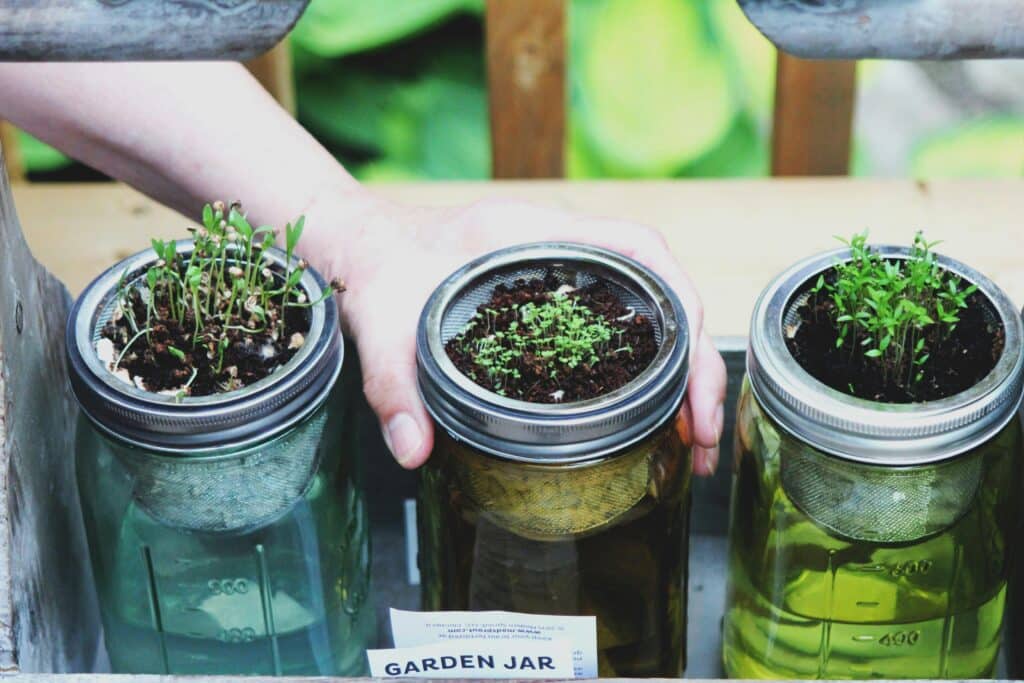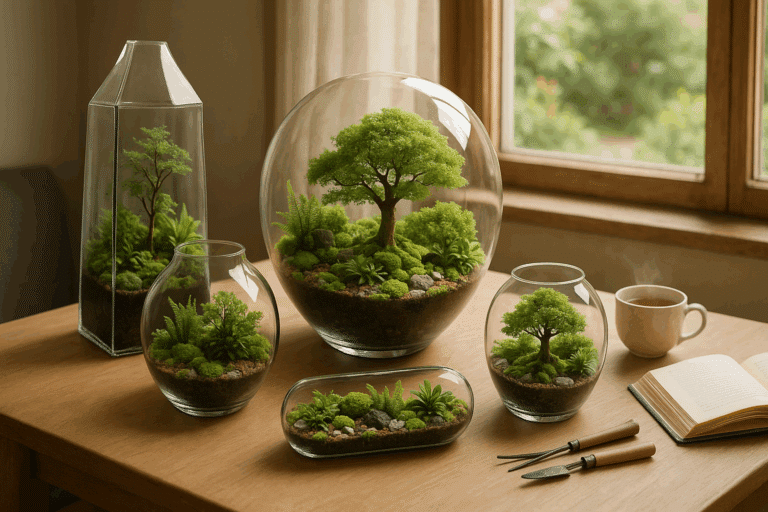Welcome to the concept of Mason Jar Herb Gardens. This DIY project is not only fun and cost-effective but also results in fresh, aromatic herbs right at your fingertips. Imagine the joy of plucking fresh basil or mint leaves right from your windowsill, adding them to your culinary creations or refreshing drinks.

Embarking on this journey of growing your own garden, in the comfort of your kitchen, will open up a new vista of flavors and aromas. In this guide, we will walk you through the process of creating your very own Mason Jar Herb Garden. A step-by-step walkthrough, taking you from choosing the right herbs to nurturing them and ensuring their healthy growth.
Moreover, this unique and innovative approach to gardening is not only limited to the kitchen. It can be a charming addition to your office desk or make for a thoughtful gift. Mason Jar Herb Gardens, with their compact size and rustic appeal, effortlessly blend with any decor, adding a touch of green and life to the surroundings.
So, are you ready to experience the satisfaction of harvesting your own herbs? Stay with us as we delve deeper into the world of Mason Jar Herb Gardens. Get ready to be enthralled by the magic of sprouting seeds and flourishing greens, bringing you fresh flavors at your fingertips. 🌿🍃
Preparing the Mason Jars for Planting
Before adding any soil or plants, Mason jars need to be properly prepared. This step is vital for preventing root rot and ensuring a healthy growing environment. First, clean each jar thoroughly using warm water and soap to remove any dust or residue that could affect plant health. Even if the jars are brand new, it’s best to sterilize them briefly with boiling water to eliminate any unseen bacteria or contaminants.
Once the jars are clean and dry, the next step is to establish a makeshift drainage system. Since Mason jars do not have holes at the bottom, it’s important to create a layer of small pebbles or gravel at the base. This layer acts as a reservoir for excess water, preventing the roots from sitting in moisture. On top of the pebbles, a thin layer of activated charcoal can be added. The charcoal helps absorb any odors, prevents mold, and minimizes bacterial growth. Only then should potting soil be added, filling the jar about two-thirds of the way.
Using the Right Potting Mix
Using the correct soil is essential when growing herbs in Mason jars. Ordinary garden soil is often too dense for container planting and can lead to compaction and poor root growth. A lightweight, well-draining potting mix designed for indoor plants or herbs is ideal. These mixes typically include components such as peat moss or coconut coir for moisture retention, perlite for aeration, and compost or worm castings for nutrients.
If you want to create your own mix, blend two parts of peat moss or coco coir with one part perlite and one part compost. This blend provides the ideal balance of drainage and nutrient content needed for healthy herb growth. Keep in mind that some herbs prefer slightly different soil pH levels or nutrient profiles, so it may be beneficial to tailor the mix slightly depending on your herb selection.
Light Requirements for Indoor Herb Growth
One of the most critical elements in maintaining a successful Mason jar herb garden is providing adequate light. Most herbs thrive in bright, indirect sunlight and need a minimum of four to six hours of light per day. South-facing windows are typically ideal for indoor herb gardens, as they offer the most consistent sunlight throughout the day.
If your space does not receive enough natural light, you can supplement with grow lights. LED grow lights are energy-efficient and provide the full light spectrum necessary for photosynthesis. Clip-on or under-cabinet grow lights can be easily positioned above your Mason jar setup. Position the light source about 6 to 12 inches above the plants and set a timer to ensure consistent exposure, usually around 12 to 14 hours daily.
Watering Practices and Moisture Management
Proper watering is essential to the success of any container garden, but especially so in Mason jars due to their lack of drainage holes. Overwatering is one of the most common causes of herb failure in this setup. The best practice is to water thoroughly but infrequently, allowing the top inch of soil to dry out before watering again.
Stick your finger into the soil up to the first knuckle to test for moisture. If it feels dry, it’s time to water. Always pour slowly to avoid oversaturating the soil. Because the jars are transparent, you can often see how much water has accumulated at the bottom. If water collects above the gravel layer, pause watering to let the soil absorb it gradually.
Misting can also help maintain humidity for herbs that prefer moist environments without overwhelming the roots. Use a fine mist spray bottle to lightly hydrate the leaves in the morning.
Fertilizing Your Indoor Herb Garden
Herbs grown in Mason jars will eventually exhaust the nutrients available in their limited soil. Fertilizing every three to four weeks can help replenish nutrients and promote healthy growth. Use an organic liquid fertilizer diluted to half strength to avoid burning the roots or leaves.
Worm tea or compost tea is a natural and nutrient-rich option that enhances soil microbiology and supports root development. Be careful not to over-fertilize, as herbs often prefer lean soil conditions. Excess nutrients can lead to lush foliage but reduced flavor intensity, especially in herbs like basil and oregano.
Pruning and Harvesting for Longevity
One of the great joys of growing herbs is harvesting them for culinary use. However, it’s important to prune your herbs properly to encourage continuous growth. Always use clean, sharp scissors or pruning shears to snip off the top few inches of the plant. Focus on cutting above a leaf node, which is the point where two leaves branch from the stem. This encourages the plant to grow fuller and bushier.
Avoid harvesting more than one-third of the plant at any given time. Over-harvesting can stress the herb and slow its growth. Regular pruning also helps to prevent herbs from flowering too early, especially in the case of basil and mint. Once a plant starts to flower, its flavor may decline.
Dealing with Common Issues and Pests
Despite being indoors, Mason jar herb gardens are not entirely immune to pests and problems. The most common issues include mold, fungus gnats, and overwatering. Mold can appear on the surface of the soil if there is too much moisture and not enough airflow. To prevent this, ensure jars are placed in a well-ventilated area and avoid overwatering.
Fungus gnats are tiny flying insects that are often attracted to moist potting soil. They can be a nuisance and may damage roots over time. Letting the soil dry between waterings and using sticky traps can help control them. Adding a layer of horticultural sand or crushed cinnamon on the soil surface can also deter egg-laying.
If herbs appear leggy or pale, it may be due to insufficient light. Move them closer to a window or adjust your grow light schedule. Yellowing leaves often indicate too much water or poor drainage.
Arranging and Displaying Your Herb Garden
Presentation can enhance the charm and functionality of your Mason jar herb garden. You can arrange the jars in a wooden crate, on a tiered plant stand, or line them up on a sunny windowsill. For small spaces, consider installing a vertical shelf or hanging the jars using metal brackets or rope macramé holders.
Label each jar with the herb name using chalkboard paint, wooden tags, or printable labels. This not only helps with identification but also adds a rustic, decorative touch. Group herbs with similar care needs together to make maintenance easier.
If your herbs outgrow their jars, you can transplant them into larger containers or outdoor garden beds while starting new herbs in the jars. This rotation system helps maintain a constant supply of fresh herbs.
Expanding Beyond the Basics
Once you feel confident in growing a few core herbs, you can begin to experiment with more exotic or less common varieties. Lemon balm, lavender, and stevia are excellent additions, each bringing a unique aroma and flavor to your collection. These herbs may have more specific light or soil needs but can thrive under the right conditions.
You can also use Mason jars to propagate herbs by taking cuttings from mature plants. Place cuttings in water until roots develop, then transplant them into soil. This method is a cost-effective way to expand your herb garden and share it with friends or family.
Beyond culinary use, herbs like lavender, mint, and rosemary can be dried and used in homemade sachets, teas, or cleaning solutions. Their multifunctionality adds even more value to your indoor garden and makes each plant a small, sustainable powerhouse.
Setting Up Your Mason Jar Herb Garden
Setting up your Mason jar herb garden is akin to building a software application from scratch. It involves careful planning, a step-by-step approach, and meticulous attention to detail.
Preparing the Jars
Just as a coder would initialize a software application, the first step in setting up a Mason jar herb garden is to prepare the jars. This involves cleaning them thoroughly and making sure they are free from any contaminants. Subsequently, it’s crucial to create a layer of gravel or pebbles at the bottom for drainage, followed by a layer of activated charcoal to prevent bacterial growth.
Planting the Herbs
Like coding the key functionalities of a software application, planting the herbs is the main part of setting up a Mason jar herb garden. Fill the jars with potting soil, leaving about an inch at the top. Then, carefully transplant your chosen herbs into the jars. Be sure not to overfill the jars as it can lead to waterlogging and root rot.
Maintaining the Herb Garden
Maintenance is to a Mason jar herb garden what debugging is to software. Regular watering, providing adequate light, and occasional fertilizing are key to the successful growth of your herbs. It’s crucial to monitor the growth and adjust the care accordingly.
Benefits and Uses of a Mason Jar Herb Garden
The benefits of a Mason jar herb garden are numerous and varied.

Fresh Flavors at Your Fingertips
Just as an effective software application enhances user experience, a Mason jar herb garden enriches your culinary experience. Fresh herbs can transform any dish by providing unique flavors and aromas.
Eco-Friendly Gardening
A Mason jar herb garden is the epitome of eco-friendly gardening. By reusing jars, you’re reducing waste and creating a sustainable ecosystem.
Space-Saving and Aesthetic Appeal
Just as a well-designed software interface is user-friendly and visually appealing, a Mason jar herb garden is space-saving and aesthetic. It’s a great way to bring greenery indoors without requiring much space. It can be displayed on a windowsill, countertop, or even hung on the wall, making it a versatile and appealing addition to any home.
By applying the principles of engineering such as systematic planning, careful implementation, and regular maintenance, you can successfully establish and grow your Mason jar herb garden, and reap its benefits.
Conclusion
In conclusion, cultivating your personal Mason Jar Herb Garden is a rewarding endeavor that brings fresh flavors right at your fingertips. These gardens not only contribute to sustainable living but also serve as a fun DIY project that adds a rustic aesthetic to any living space. By growing your herbs, you can ensure a constant supply of fresh, organic ingredients that can elevate the taste of your meals, providing a culinary experience that is both healthy and delightful.
Moreover, these herb gardens offer an unparalleled convenience. They fit snugly into any space, be it a sunny windowsill or a tiny apartment kitchen. Also, the process of tending to these plants can be therapeutic and educational, helping you learn about the growth cycles of different herbs.
Ultimately, Mason Jar Herb Gardens are more than just a gardening trend. They represent a lifestyle choice that promotes healthier eating, environmental consciousness, and a closer connection to nature. Now, there’s no excuse for not having fresh herbs on hand when you can grow them right in your own home. A Mason Jar Herb Garden is a small step towards a greener, healthier life, and a flavorful journey that starts right in your kitchen.



